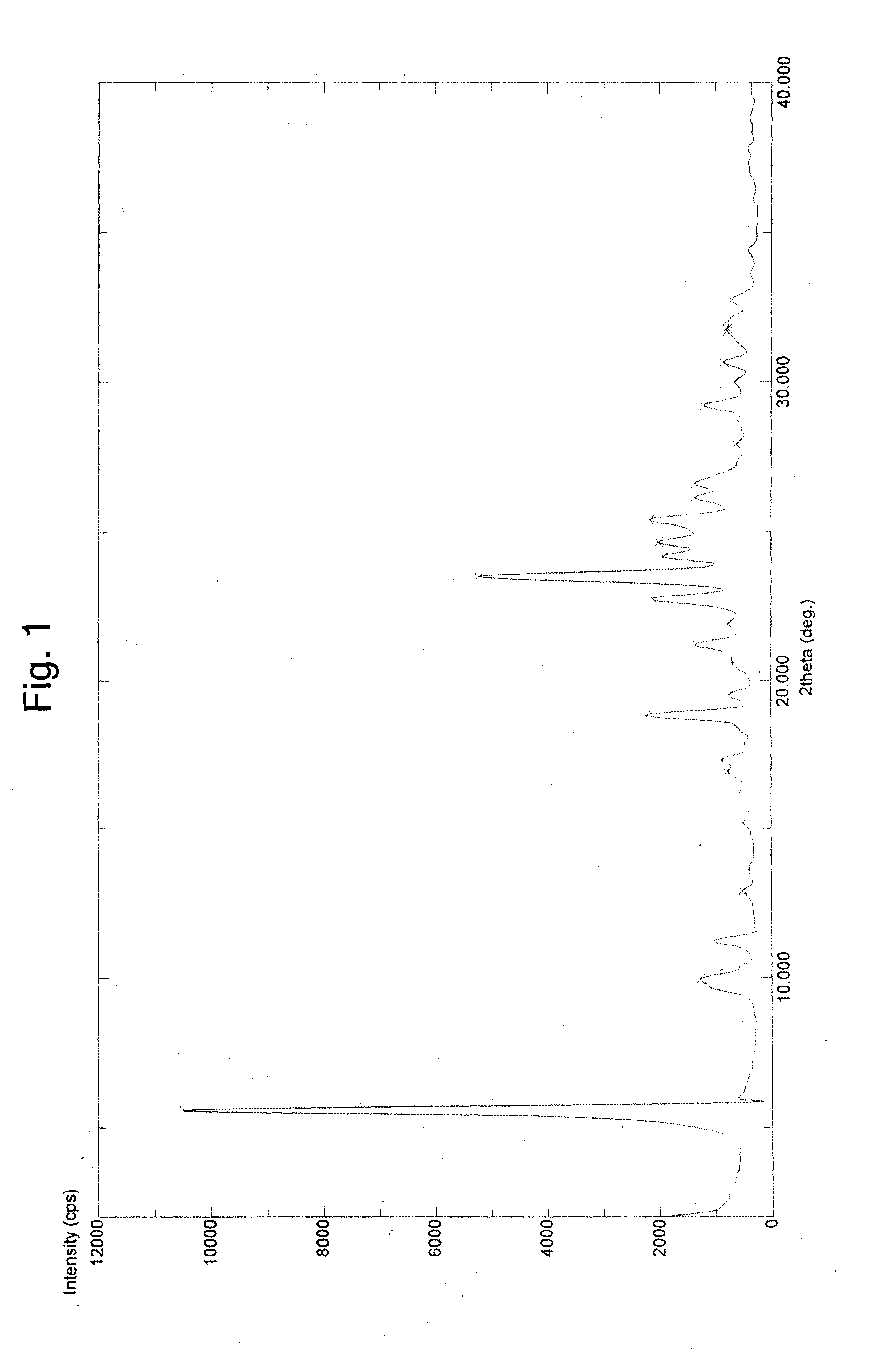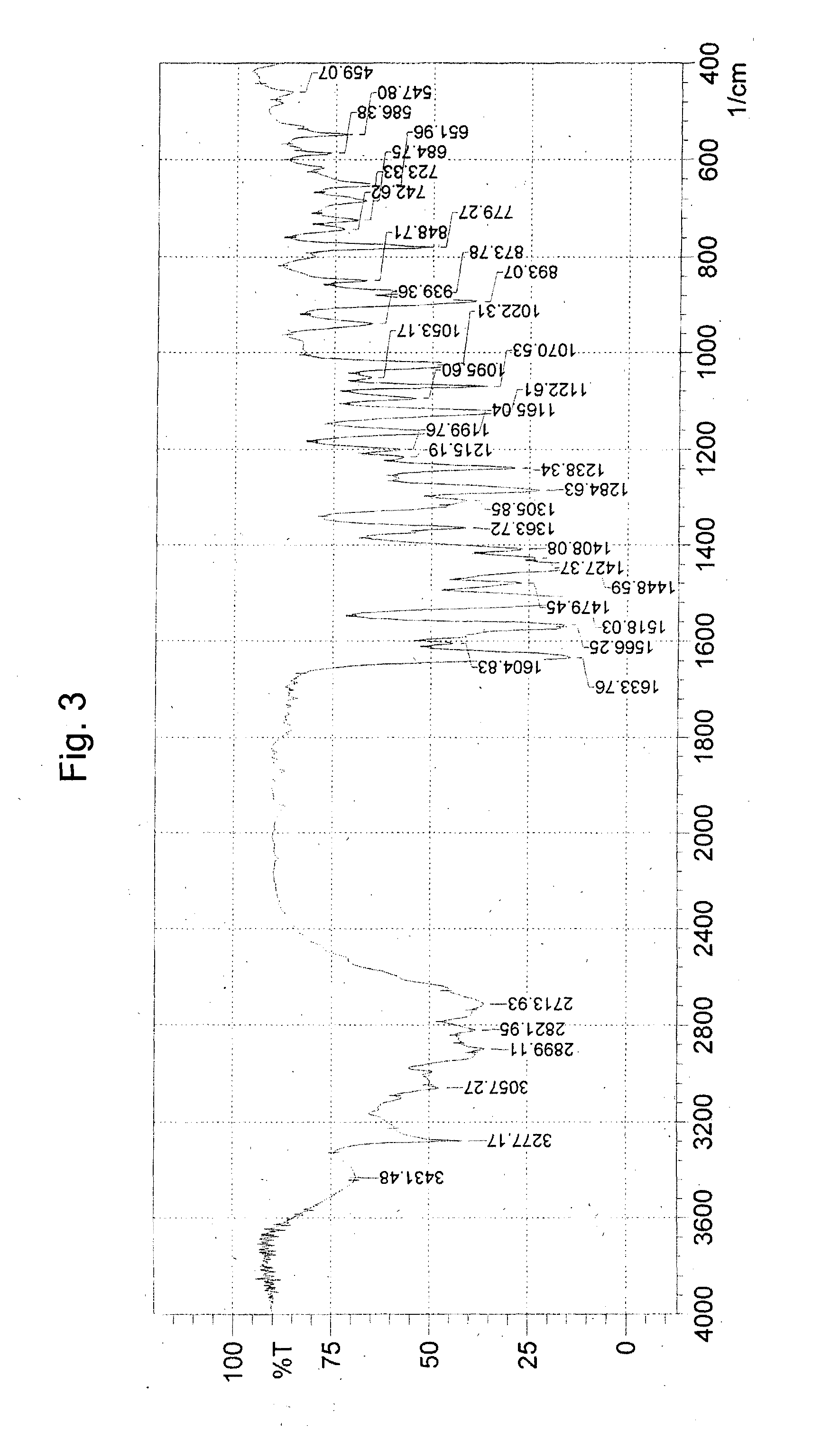Process for preparing stable polymorphic form of erlotinib hydrochloride
a technology of erlotinib hydrochloride and stable polymorphism, which is applied in the field of process for preparing a stable polymorphic form of erlotinib hydrochloride, can solve the problems of high cost of process and inability to commercializ
- Summary
- Abstract
- Description
- Claims
- Application Information
AI Technical Summary
Benefits of technology
Problems solved by technology
Method used
Image
Examples
example 1
Preparation of 4-Chloro-6, 7-bis-(2-methoxyethoxy)quinazoline (ClBMEQ)
[0107]Into a reaction vessel, BMEQ (1 gm, 3.4 mmol) and thionyl chloride (6 ml, 82.71 mmol) was added under stirring and nitrogen purging. Further DMF (0.1 ml, 1.3 mmol) was added in reaction mass and refluxed for 1-4 hours. The excess thionyl chloride was evaporated under vacuum and cooled the residue to room temperature and added 5 ml dichloromethane and 5 ml saturated solution of sodium bicarbonate with continuous stirring. The organic layer was separated and washed with saturated solution of sodium bicarbonate and water. The organic layer was separated, dried over sodium sulphate and concentrated the organic layer till one volume of MDC remains. To this was added 10 ml of Isopropyl alcohol, cooled to 0-5° C., stirred for 30 min. Filtered the material and air dried under 9 mbar vacuum for 30 min to get 856 mg ClBMEQ (Yield=80.8%, Purity=98.70%).
example 2
Preparation of 4-Chloro-6,7-bis-(2-methoxyethoxy)quinazoline (ClBMEQ)
[0108]Into a reaction vessel, BMEQ (1 gm, 3.4 mmol) and thionyl chloride (6 ml, 82.71 mmol) was added under stirring and nitrogen purging. Further DMF (0.1 ml, 1.3 mmol) was added in reaction mass and reflux for 2 hour. The excess thionyl chloride was evaporated under vacuum, further cooled the residue to room temperature and added 5 ml dichloromethane and 5 ml saturated solution of sodium bicarbonate with continuous stirring. The organic layer was separated and washed with saturated solution of sodium bicarbonate and water. The organic layer was separated, dried over sodium sulphate and concentrated the organic layer till one volume of MDC remains. Then 10 ml of Isopropyl alcohol was added into RM, cooled to 0-5° C., stirred for 30 min. Filtered the material and air dried under 9 mbar vacuum for 30 min to get 927 mg ClBMEQ (Yield=87.5%, Purity=83.79%).
example 3
Preparation of 4-Chloro-6,7-bis-(2-methoxyethoxy)quinazoline (ClBMEQ)
[0109]Into a reaction vessel, BMEQ (1 gm, 3.4 mmol) and 10 ml MDC was added under stirring and nitrogen purging. Then DMF (0.12 ml, 1.61 mmol) was added in RM and cool to 20-30° C. The Thionyl chloride (1.65 ml, 22.75 mmol) was added dropwise while maintaining the temperature between 20-30° C. Reflux the RM up to 5 hour. The pH of RM was maintained 6 to 7 by using 10% NaOH solution. The organic layer was separated, dried over sodium sulfate and concentrated the organic layer. 10 ml of n-Heptane was added to the residue and stirred. The RM was cooled to 10-15° C., stirred for 1 hour, filtered, washed with n-Heptane and air dried the compound under 9 mbar vacuum for 30 min to get 929 mg ClBMEQ (Yield=87.6%, Purity=97.65%).
PUM
| Property | Measurement | Unit |
|---|---|---|
| melting point | aaaaa | aaaaa |
| temperature | aaaaa | aaaaa |
| melting point | aaaaa | aaaaa |
Abstract
Description
Claims
Application Information
 Login to View More
Login to View More - R&D
- Intellectual Property
- Life Sciences
- Materials
- Tech Scout
- Unparalleled Data Quality
- Higher Quality Content
- 60% Fewer Hallucinations
Browse by: Latest US Patents, China's latest patents, Technical Efficacy Thesaurus, Application Domain, Technology Topic, Popular Technical Reports.
© 2025 PatSnap. All rights reserved.Legal|Privacy policy|Modern Slavery Act Transparency Statement|Sitemap|About US| Contact US: help@patsnap.com



